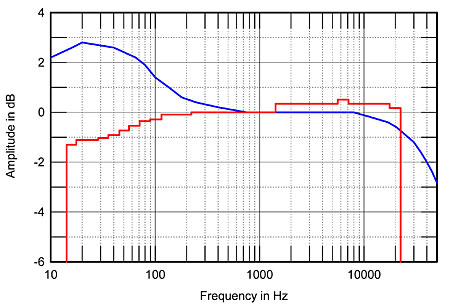| Columns Retired Columns & Blogs |
Audio By Van Alstine Super-PAS Three preamplifier Measurements
Sidebar 3: Measurements
The most important measured quality of a tube preamplifier, for me, is the noise level on its phono input. With the inputs shorted, I measured the S/N ratio to be 54dB wide-band, and 69dB A-weighted (both figures referred to a nominal output of 1.5V). This is a respectably low noise level for a tube design, though not quite sufficiently low to make feeding a low-output MC straight in a viable proposition. It must be due in part to the heavy-duty power supply installed by Mr. Van Alstine. There should be no problems with conventional MM cartridges or high-output MCs, however. The care taken in keeping the signal paths for each channel isolated from each other results in low levels of crosstalk, buried in the noise at 1kHz and 20Hz and rising to –47dB at 20kHz for line-level signals. Separation at 20kHz was reduced by about 5dB via the phono inputs, but this is still very good, in my opinion.
The blue trace in Fig.1 shows the response of the phono input (the channels were pretty much identical), measured with spot sinewaves and the Old Colony inverse-RIAA network, which should be accurate to within 0.2dB. The HF response can be seen to roll off sensibly above the audio band, with the –3dB point lying at 52kHz, resulting in a harmless droop of 0.6dB at 20kHz. The LF extends rather more than I would have thought wise, however, with the –3dB point at 3Hz. The Super-PAS will thus act as an open window to warp-induced subsonic garbage, making use of a high-quality turntable essential if your woofer cones are not to flap alarmingly. In addition, the phono section's bass region seems to be exaggerated in level by up to 2.8dB at 20Hz, echoing Gordon's description of the sound of the original Dynaco PAS. But wait a second—I didn't find that the Super-PAS sounded too rich in the low bass. The red trace in fig.1 shows the RIAA response measured with 1/3-octave pink noise; the bass lift is now conspicuous by its absence, and it is this measurement that agrees with what I heard.

Fig.1 AVA Super-PAS 3, RIAA error measured with spot tones (blue trace) and with 1/3-octave pink noise (red) (1dB/vertical div.).
Discussing this discrepancy with Mr. Van Alstine revealed that it was a consequence of the particular RIAA EQ topology he uses. His implementation of the bass section of the EQ gives a flat response under dynamic conditions, as with the noise signal—and music—but steady-state test conditions give an apparent low-bass boost. With hindsight, I can't see why I was surprised. Wasn't it only last month that I discussed the subjective nature of supposedly objective tests in "As We See It"? This signal sensitivity, however, suggests that it might be possible for the phono section to change its low-frequency character somewhat according to the type of cartridge used, a high-output 'coil providing a different source loading from that of a typical MM, for example.
The output impedance at 1kHz was typical for a tube design lacking a cathode follower at 2k ohms, and the Super-PAS 3 will therefore probably be more cable-sensitive than most, particularly when used with solid-state power amplifiers having an input impedance of 10k ohms or so. Interconnect cables are best kept short. Many feel that adding the very common follower stage to enable a tube preamp to more effectively drive cables can reduce overall transparency, due to the extra tube in the circuit. Frank Van Alstine, however, feels that cathode followers have even had too good a press regarding their fundamental task, negative-flowing current being restricted by the limitations imposed by the plate current. If it can't do the job, why bother with it?
The Super-PAS's input sensitivities and gain structure—40dB at 1kHz phono, 20dB at 1kHz line, the latter reducing to 15dB with the overall attenuation due to the volume and balance control—are well-managed, with the volume control having to be used well up with typical power amplifiers, where its interchannel matching will be best and where the steps between adjacent settings are not too large.—John Atkinson
- Log in or register to post comments




































